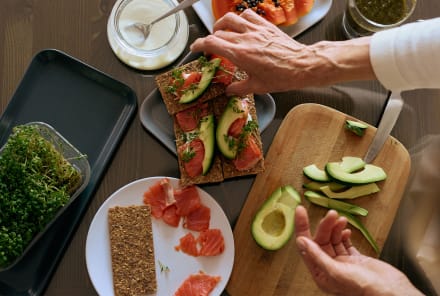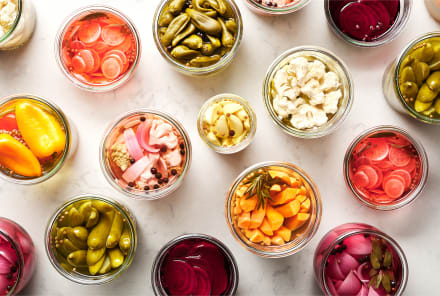Advertisement
How To Strengthen Your Community Ties In The New Year


Human beings need to socialize. Yet more often than not, spending time with others is seen as frivolous and less essential to health than diet or exercise. It’s time to change that.
Research shows that the quality of our social relationships significantly influences mortality risk1. In 2024, consider shifting your focus away from fleeting diet trends and towards something undeniably beneficial for emotional well-being and longevity. Here's why strengthening your community ties is essential, and actionable ways to do so this year.
Why to make this the year you strengthen your community
First, let’s talk about your brain on social connection.
“Everything that we do when we interact with others in an authentic way increases neurotransmitters and hormones in the body and brain that are critical for feeling joy and mental health and well-being,” explains neuroscientist, board-certified psychiatrist, and founder of wearable tech brand Apollo, Dave Rabin, M.D.
Beyond the brain health and mood benefits, building community can have a positive ripple effect on other, often unexpected, areas of health.
A review of 34 different clinical studies on social connectedness and long-term care outcomes found positive associations between a strong sense of connection and a long list of physical health outcomes, including sleep, nutrition, stress, frailty, fatigue, and yes, overall mortality.
This specific finding with older adults is an interesting juxtaposition given that community building is often prioritized in childhood, and seen as less important as we age and gain independence. But clearly, the benefits of community have no age limit and should never be put on the back burner.
Another study found that volunteering can have positive mental and physical benefits2 for the volunteers, especially for vulnerable groups, including adults over the age of 60 and those struggling with their health.
One 2022 study shows that social isolation and feelings of loneliness have even been associated with increased dementia risk3.
Socialization plays such a key role in brain health that addiction specialists often cite it as one way to lower addiction risk and help support recovery as well.
Rabin explains that the neurotransmitters and hormones activated by social connection are the same ones triggered by certain drugs, listing dopamine, serotonin, oxytocin, endorphins, endogenous opioid molecules, and endocannabinoid molecules as examples—just to name a few.
“All of these are increased by authentic genuine connection,” he states. “A lot of the modern theory supports that having more human connection (soothing touch, eye-to-eye contact, empathy, smiles, hugs, etc.) are all essential to us feeling better and could be a huge resource and ally in tackling the addiction epidemic,” Rabin explains.
Of course, addiction is extremely complex and personal. But, this knowledge helps to build the case for making social connectedness a priority for optimal mental and physical well-being.
So, if you’re seeking a longer, happier life, know that it doesn’t start and end with how you eat or how much you exercise. Your mental health and relationships are central pieces of the puzzle.
Actions that strengthen community ties
Find (and stick to) a third place
In sociology, the concept of a third place refers to a location apart from your home and work that gives you some form of social connection. Some common examples of third places are gyms, churches, parks, cafes, etc.
If you don’t have one yet, make 2024 the year you find (and build) your third place. The latter half of the resolution is where the challenge comes in because third places aren’t born just from going somewhere repeatedly—just like with a workout-based resolution, it takes commitment and effort to form social bonds over time. In other words: It's not just a place to go but a place to go and socialize, so try to make verbal connections with someone each time you go.
Now, this third place should be somewhere that sparks joy or contentment, so don’t try to mold your cycling class into your third place if you generally prefer to get in and out of there as fast as possible. Building a third place does take work, but it shouldn’t feel forced.
Start or join a club
There’s a reason we encourage children to join clubs, team sports, and art classes: They provide a community base with those with similar interests and passions. Plus, they can teach us something new or help us refine our skills in the process.
If you don’t feel up to joining a club, or you can’t find one you like, consider starting your own. Even a three-person bi-weekly book club will provide social interaction, something to work toward, and open the door for new friendships later down the road.
This could be around physical activities such as running, dance, or pickleball, or something related to art like painting, pottery, or knitting. All you really need is a shared interest with one other person to get started.
Volunteer in your community
Another way to connect with the community is through volunteer work. Not only will this help you meet new people, especially those with different interests and backgrounds, but it’ll also support a feeling of purpose and belonging.
“Positive emotions that come from these activities include gratitude, compassion, empathy, a general sense of being part of something bigger than us (really essential to our overall mental and emotional well-being),” Rabin says.
He further explains, “If we are working in a constructive volunteering environment, people will express gratitude for their work. That mutual expression of ‘I’m doing something to contribute back to the community without expectation of anything in return’ and receiving thanks for participating and providing is one of the most core fundamental ways we feel joy as humans—the authentic connection to others without anything in return.”
That last part is key: volunteering should not be driven by the hope of a transaction of any kind. Once these activities do become transactional, many of the positive benefits for both mental health and the community can get clouded.
Look for volunteer opportunities that spark your interest, be it working at an animal shelter, local garden, donation center, clean-up project, etc. This way, you’ll be more likely to stick with it. And if you feel nervous about volunteering somewhere new, bring a friend to add a level of security (the more, the merrier, right?).
Use public resources
Finally, make use of public resources. The more you spend time in local parks, libraries, and community centers, the more invested you’ll become in the people there and you may even feel inspired to contribute to their upkeep in return.
Investing time and energy into these spaces can help you feel integrated and invested in your community, which can then contribute to positive emotions and outlooks on where you live and who you live around.
So many opportunities for socialization are built into towns and cities; you just have to take some time to look for them.
Your 'Stronger Together' plan
Set a strong base:
Looking at the four examples above, pick just one to start in the new year. Consider having a friend or family join you on your first venture to ease any jitters or hesitation.
If you want something more structured, schedule one community-building activity each month of 2024. Then, add on as you see fit.
The level up:
For those already immersed in their community, why not make your goal to bring friends and family into the picture? Next time you head to a new coffee shop, sign up for a volunteer event, or join a new club, invite a friend or family member to join you.
By doing so, you’ll spread the joy and great longevity benefits that the community can bring to even more people. Plus, it may help to strengthen your relationship with that person as well—a win-win for the both of you and your community.
Watch Next
Enjoy some of our favorite clips from classes
Enjoy some of our favorite clips from classes
What Is Meditation?
Mindfulness/Spirituality | Light Watkins
Box Breathing
Mindfulness/Spirituality | Gwen Dittmar
What Breathwork Can Address
Mindfulness/Spirituality | Gwen Dittmar
The 8 Limbs of Yoga - What is Asana?
Yoga | Caley Alyssa
Two Standing Postures to Open Up Tight Hips
Yoga | Caley Alyssa
How Plants Can Optimize Athletic Performance
Nutrition | Rich Roll
What to Eat Before a Workout
Nutrition | Rich Roll
How Ayurveda Helps Us Navigate Modern Life
Nutrition | Sahara Rose
Messages About Love & Relationships
Love & Relationships | Esther Perel
Love Languages
Love & Relationships | Esther Perel

















